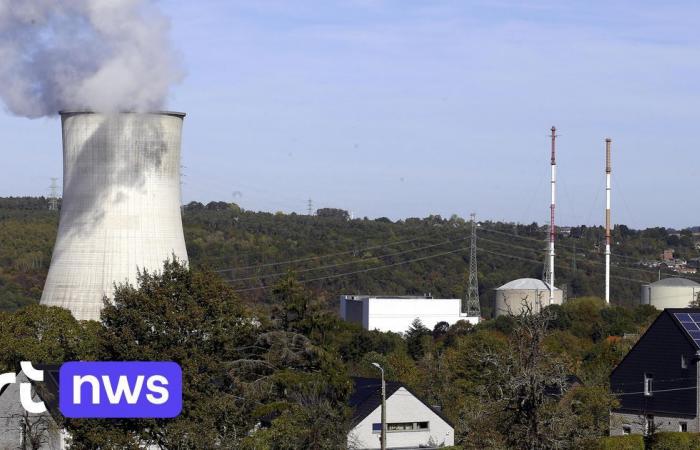Doel 3 is one of our younger and larger reactors. It was started in 1982 and must therefore be closed after 40 years according to the law on the nuclear exit. That is at the end of next week: in the night of Friday 23 to Saturday 24 September, the reactor will be taken off the grid. It will be the first reactor to be officially decommissioned.
Is it safe to keep Doel 3 in service longer?
Until recently, the closure was almost undisputed. In 2012, an ultrasonic scan found impurities in the nuclear reactor wall. Such impurities were also found in contemporary Tihange 2. The two reactors became known as the “fracture power plants”. In the end, it turned out to be the traces of squashed hydrogen bubbles, which were formed when the 20 centimeters thick steel was cast and flattened in the late 1970s.
The reactor was shut down for almost 3 years with a short interruption. After a thorough examination, the cornflake-like impurities inside the steel wall were not found to be due to the operation of the nuclear reactor itself. They had just always been there. There was also no indication that the spots would grow. The nuclear reactor wall was also screened during every major maintenance. No new impurities were added and the existing stains did not get bigger.
The crack reactor might still be able to keep up
The research of the SCK in Mol, in which several international experts were involved, including the renowned Oak Ridge laboratory in the US, showed that the nuclear reactor wall could last for more than 40 years. The FANC retained a margin of 47 years. Additional studies even pointed to 70 years. But they have yet to be confirmed. If the FANC wants additional research to keep the reactor on standby for longer, we can easily be away for a few months.
Years of security research needed
Then we are only talking about the investigation of the nuclear reactor wall. But if you want to keep a nuclear power station running for longer, a lot of extra research and investments are required. All parts (refrigeration circuits, steam generator, turbine, pumps, buildings) must be thoroughly checked and, if necessary, replaced. By certified components, which are made by specialized companies. Safety is not taken lightly in the nuclear sector. The FANC closely monitors the quality of the components and the work performed. As a result, they can take months or years: giving in to them is out of the question.
The law doesn’t really allow it
Also in legislation, Doel 3 and Tihange 2 do not exactly have the wind in their favor. According to the 2003 nuclear phase-out law, the reactors had to close after 40 years. That closure has always stood out. No politician wanted to burn himself on it. Keeping the “crack reactors” open for longer, that was unsaleable for the public, most political parties feared. Even from the nuclear sector there was hardly any resistance.
The law on nuclear exit has therefore never been amended before the closure of Doel 3 and Tihange 2. If Doel 3 still has to be extended in a week and a half, even for a few days, then the law must be amended without delay. But that is not easy, as past experience shows.
When at the end of 2014 the Michel 1 government decided headlong to extend our two oldest nuclear reactors, Doel 1 and Doel 2, it took months before the law was finally approved in parliament. That was in the summer of 2015. Almost 4 months after the original closing date of Doel 1. Electrabel did not take any risks and nevertheless shut down the nuclear reactor until the amended law was approved. Against the will of the government, but in fact the company had little choice. The enforced violation of the law would certainly be seized upon by anti-nuclear movements to take Electrabel to court.
The “njet” of Electrabel
So Electrabel said no, and will now do so as long as there is no certain legal framework. Moreover, the legislation has been tightened up since 2015. From now on, Europe will require an Environmental Impact Assessment (EIA) with a public inquiry when a nuclear reactor is extended. Within a radius of 1000 kilometers around the power station. A total of 16 neighboring countries should be informed about the extension of the lifetime of Doel 3. This includes Austria and Germany, which have previously opposed the extension of our two youngest nuclear reactors. Organizing such a public survey in barely a week seems like a mission impossible.
War breaks law?
But of course we are in a war situation, with Russian leader Putin trying to squeeze Europe to death economically with his energy weapons gas and oil. Emergency breaks the law, the saying goes. Our government has used that saying several times. With some help from Europe, which may turn a blind eye, many legal hurdles may be cleared more quickly. But so smoothly that everything will be legislated in a week, that becomes very unlikely.
The fuel has run out
There is also another legal problem, with the fuel from the nuclear reactor. It is legally over. A fuel cycle is legally defined at 365 days. For Doel 3, that cycle ended on 1 October, exactly when the reactor was legally required to close. Because a maintenance service went faster than expected and the power station could therefore be restarted faster, the fuel has “legally” run out a week earlier, on September 23. In order to be able to keep Doel 3 running for longer, this legal provision will have to be amended.
Exhausted fuel already leads to less power
In addition, the fuel is also just physically at the end of its rope. The reactor has therefore gradually started to produce less in recent months and is now between 60 and 65 percent of its capacity. In fact, “his gas tank” will be as good as empty by the end of next week. Experts estimate that the remaining “petrol vapours” will allow the reactor to survive for a maximum of one to two weeks. And explaining the reactor right now to keep it running for a few more weeks with its remaining fuel in a few months is virtually impossible. A reactor is not a car: if you want to restart it with its reduced power, it takes a lot of time. If it is possible anyway: a reactor becomes very stiff at the end of a fuel cycle and you cannot just switch it on or off.
Moreover: if you are standing in front of the scrap heap with a car with an empty tank, you can quickly fill it up around the corner: plenty of gas stations. But nuclear fuel elements for nuclear reactors are not just around the corner. These have to be ordered years in advance and made in special factories. However, there may still be some fuel rods left in France, now that several French nuclear reactors have been taken off the grid due to breakdowns. Engie might be able to buy it soon.
New fuel is expensive
The question then is: at what price? Because a single charge from a nuclear reactor can easily cost several tens of millions of euros. You don’t just put that money on the table. Certainly not with a fickle government like ours, where you never know how long you can keep your nuclear reactor running. Verlinden has not even made it clear whether Doel 3 should start up, let alone when and how long it should run. Goal 3 should just be kept in reserve. He may never get back into action and Engie has lost tens of millions in unused fuel.
In addition, the reactor will also have to be refurbished. As a reminder: for Doel 4 and Tihange 3, experts who work optimistically estimate a total of more than 1 billion euros. Doel 3 will probably be even more expensive in relative terms, if only because the nuclear reactor wall will also have to be examined additionally. And Engie is definitely not eager to cough up those pennies.
The organization and the people
The cost will also increase because Engie-Electrabel will have to turn its entire planning upside down if it were to respond to Minister Verlinden’s request to keep the reactor on standby for longer.
After all, the closure of Doel 3 has been prepared for years. In agreement with the FANC, it has been decided to start the decommissioning works as soon as possible, in order to guarantee maximum safety. Immediately after disconnecting the reactor, Electrabel gets to work. First, the fuel elements are removed from the reactor and stored in cooling baths for three years. This work will start almost immediately, in October, and will take approximately 1 to 2 weeks.
Chemical cleaning makes the power plant unusable
Shortly afterwards, the chemical cleaning of the primary cooling circuit will start. The radioactive particles that have settled on the inside of the tubes and the pumps are chemically ‘scraped away’. At that moment it is virtually impossible to restart the reactor. no longer meet safety standards.
It is this chemical cleaning that our government is so apprehensive about. It will almost certainly mean the end of Doel 3. Keeping the reactor in reserve is then no longer an option. Hence the request from Minister Verlinden to postpone those works.
That in itself is not impossible. During the research into the hydrogen inclusions, Doel 3 was out for years. In 2015 it was restarted without any problems. But the cooling circuit was not chemically cleaned at that time.
Breaking contracts costs money
In addition, Engie-Electrabel has already recruited specialized companies well in advance to start the preparatory decommissioning works. Breaking those contracts in a hurry now will cost money. Not to mention the organizational and personnel problems. A number of Doel 3 employees have been reoriented for some time to other jobs within Engie or have simply left the company. Experts therefore fear that Engie-Electrabel will not even have enough qualified personnel to keep the reactor working safely any longer. Immediately after Verlinden’s question, Engie responded that keeping Doel 3 in reserve is almost impossible.
Emergency scenarios in times of war
The hasty call from Minister Verlinden and other government parties to keep Doel 3 on standby for longer, however, ignores many practical, legal, financial and security questions. But we are in an economic war and we also bear the consequences of years of volatile energy policy. Then it is easier to put on the table emergency scenarios that are not well thought out. Emergency scenarios may stand a chance in these times of war, but it is also possible that they will simply be brushed aside.






